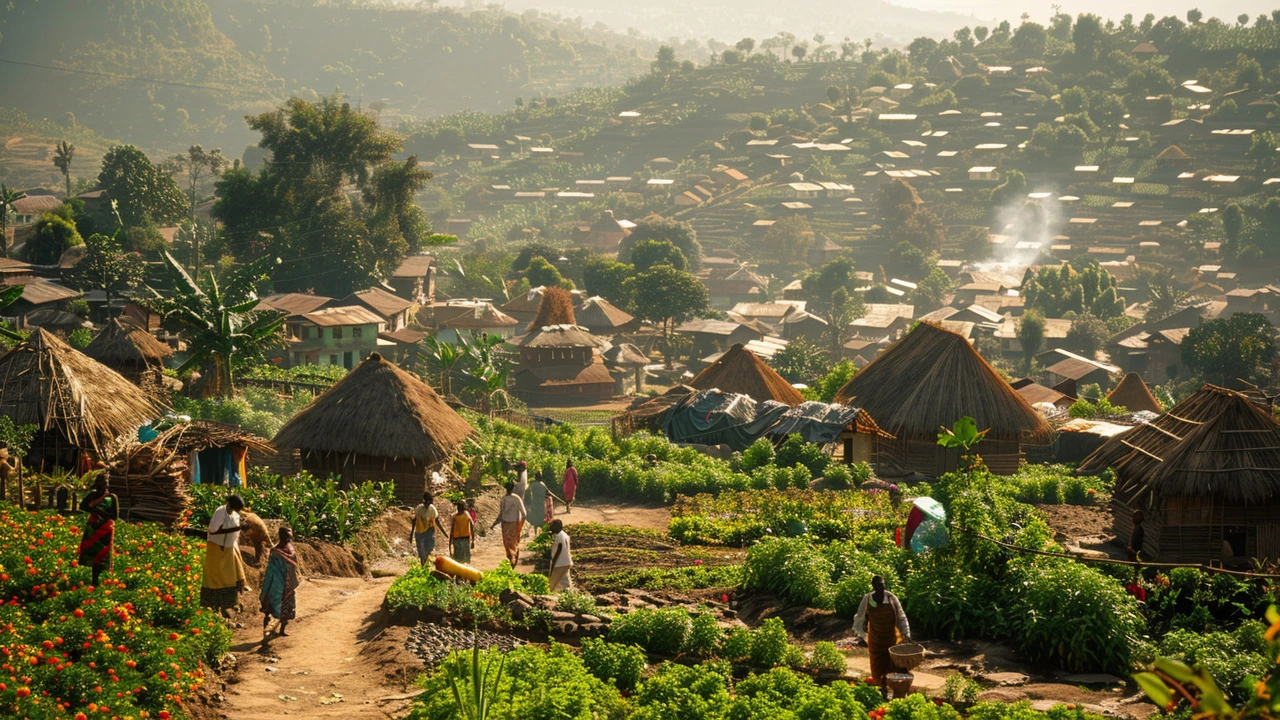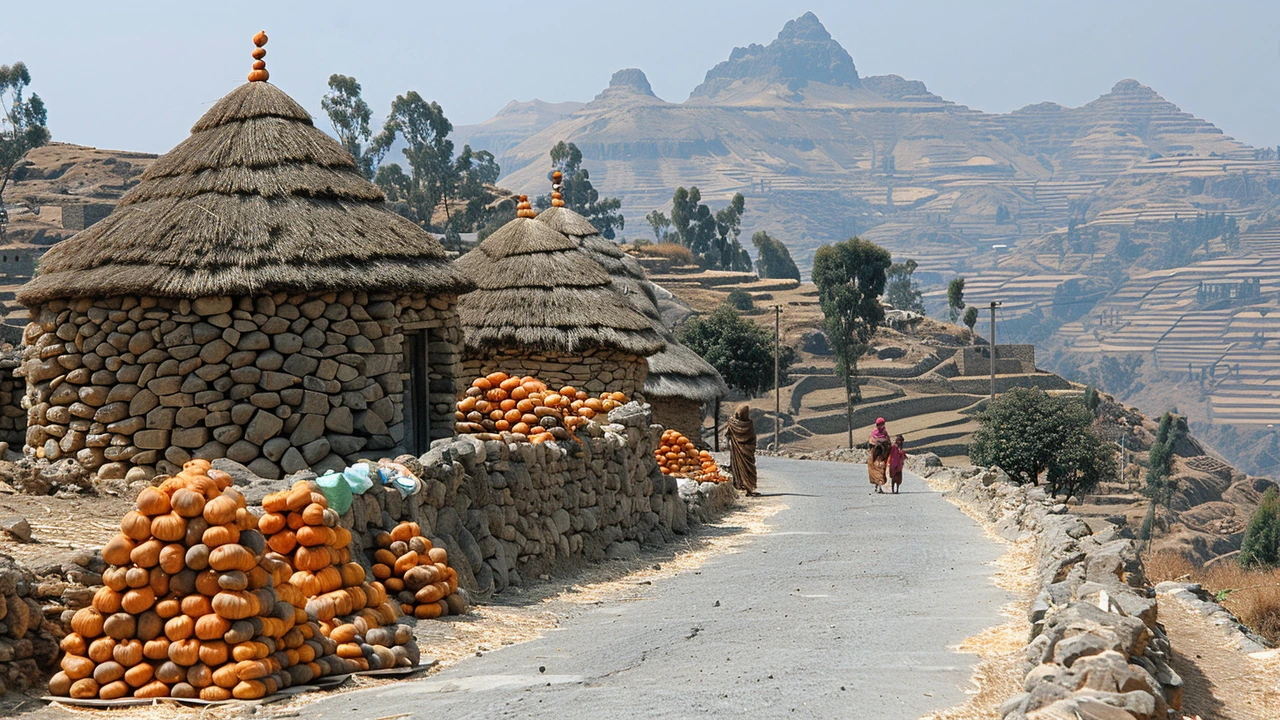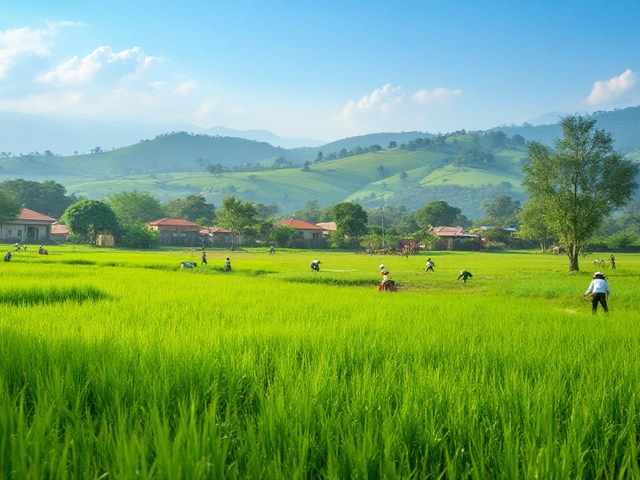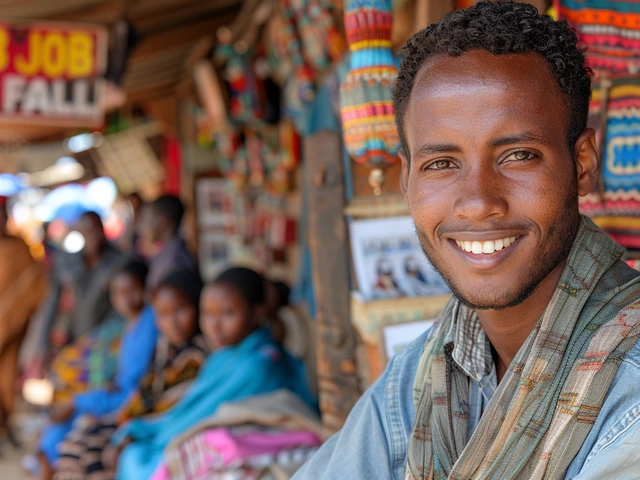Ethiopia, a land renowned for its ancient history and diverse cultures, has been grappling with poverty for decades. While the country has made strides in economic growth and development, the struggle to alleviate widespread poverty continues to be a pressing issue.
This article sheds light on the complexity of poverty in Ethiopia, providing readers with insights into its historical roots, current challenges, and the disparity between urban and rural areas. Additionally, it explores how various factors, including educational access, employment opportunities, and governmental policies, play a role in shaping the socio-economic landscape. Discover the efforts being made by the government and non-governmental organizations (NGOs) to uplift communities and the potential paths forward for the nation's future.
- Historical Context
- Current State of Poverty
- Rural vs. Urban Poverty
- Factors Contributing to Poverty
- Government and NGO Efforts
- Future Outlook
Historical Context
Delving into the history of poverty in Ethiopia requires an understanding of the country’s rich yet tumultuous past. Located in the Horn of Africa, Ethiopia is one of the oldest nations in the world, with a history that stretches back to the ancient kingdom of Aksum. The legacy of this ancient civilization is immense, but its historical trajectory has also been shaped by numerous challenges, marking the path towards the current socio-economic conditions.
From the 19th century onwards, Ethiopia, unlike many African countries, successfully fended off colonial powers, notably defeating Italy in the Battle of Adwa in 1896. This era of resistance did help maintain its sovereignty, but it also limited the influx of foreign investment and infrastructure development seen in other colonies. By the mid-20th century, under Emperor Haile Selassie, modernization efforts were initiated, but they were often sporadic and unevenly distributed between urban and rural areas.
In 1974, the Derg regime, a Marxist-Leninist military junta, overthrew Selassie. The subsequent years under the Derg were marked by centralized control and severe repression, alongside attempts at land reform and collectivization. However, droughts in the 1980s, compounded by internal conflict, led to catastrophic famines that brought international attention to Ethiopia's suffering. A report from that era revealed that nearly one million Ethiopians died from famine between 1983 and 1985.
The fall of the Derg in 1991 ushered in a new period under the Ethiopian People's Revolutionary Democratic Front (EPRDF). This coalition attempted to introduce measures aimed at economic stability and growth. Despite these efforts, poverty remained a persistent issue, primarily due to the previous decades of turmoil and underdevelopment. The Ethiopian government, with support from international organizations, initiated various programs aimed at reducing poverty and improving infrastructure.
Reflecting on the historical context of poverty in Ethiopia, it's essential to recognize how deeply interwoven the socio-political dynamics are. A quote from Gebreab Zegeye, an economic historian, encapsulates this: "Understanding Ethiopia's poverty is impossible without considering the weight of its history, a history that is as much about triumph and resistance as it is about struggle and survival."
Current State of Poverty
As of 2024, Ethiopia continues to face significant challenges related to poverty, despite notable economic growth over the past decade. The country is home to over 120 million people, with a large percentage living below the poverty line. According to the World Bank, around 24% of Ethiopians live in extreme poverty, surviving on less than $1.90 a day. This issue is more pronounced in rural areas, where access to basic needs such as clean water, healthcare, and education remains inadequate.
Rural poverty is driven by a lack of infrastructure and limited access to markets, making it difficult for farmers to sell their produce and earn a sustainable income. Agriculture is the main source of livelihood for about 70% of the population, but many smallholder farmers struggle with low productivity due to traditional farming methods and unpredictable weather patterns. Climate change exacerbates these challenges, causing frequent droughts and floods that destroy crops and livestock.
In urban areas, poverty manifests differently. Cities like Addis Ababa attract people from the countryside seeking better opportunities, creating challenges such as overcrowding and unemployment. While the government has invested in infrastructure projects aimed at improving urban living standards, the rapid population growth outpaces these efforts. Many urban dwellers live in informal settlements with limited access to basic services.
The health sector in Ethiopia also reflects the dire state of poverty. Many communities, especially in remote areas, lack access to adequate healthcare services, leading to high maternal and infant mortality rates. According to UNICEF, Ethiopia's under-five mortality rate is 55 per 1,000 live births, and maternal mortality remains high at 401 deaths per 100,000 live births.
Education is another critical area impacted by poverty. Although primary school enrollment has improved, many children drop out due to economic hardships, limiting their future prospects. Secondary school attendance is significantly lower in rural areas compared to urban regions, further perpetuating the cycle of poverty.
The Ethiopian government, along with international organizations, has implemented numerous programs to address poverty. Initiatives such as the Productive Safety Net Program (PSNP) provide food and cash support to vulnerable households, while agricultural extension services aim to improve farming practices. Additionally, efforts to expand access to healthcare and education are ongoing, although challenges remain.
Moreover, growth in sectors such as manufacturing and services offers potential opportunities to diversify the economy and create jobs. However, achieving long-term poverty reduction requires sustained commitment and addressing structural issues that impede progress. As Ethiopia navigates its path forward, the resilience and determination of its people remain a source of hope and inspiration.

Rural vs. Urban Poverty
Ethiopia's poverty profile reveals a stark contrast between rural and urban areas. The majority of the population resides in rural regions, where the poverty rate remains considerably higher than in urban centers. Rural areas, dependent largely on subsistence agriculture, face numerous challenges including limited access to essential services, poor infrastructure, and vulnerability to climatic changes, which significantly impact agricultural productivity. These factors contribute to a cycle of poverty that is hard to break.
In contrast, urban areas like Addis Ababa have seen comparatively better economic development due to industrialization and job opportunities that attract people from rural regions. However, this influx often leads to overcrowding and strains on city resources, resulting in the growth of urban slums where people live in inadequate housing conditions, lacking basic amenities like potable water and sanitation. Unemployment among urban youth is also a significant concern, as it fuels poverty and social unrest.
The Ethiopian government, along with international organizations, has been implementing various programs to bridge the disparity. For instance, the Productive Safety Net Programme (PSNP) aims to support rural communities by offering labor opportunities in public works in exchange for food or cash, helping to stabilize their income. In urban settings, initiatives like the Urban Productive Safety Net Programme (UPSNP) focus on providing job training and employment opportunities to the unemployed.
"The rural-urban divide in Ethiopia is one of the most critical issues to address in our fight against poverty. Sustainable solutions require comprehensive approaches that incorporate agricultural development and urban planning." – World Bank Report
Another dimension of this divide is the accessibility to education. In rural regions, schools often have limited resources, lack qualified teachers, and are located far from communities, which discourages attendance. Urban schools, though relatively better equipped, still face challenges like overcrowding and resource allocation. Improving educational facilities and providing quality education in rural areas could play a critical role in reducing poverty.
Health services also highlight the rural-urban divide. Urban residents have better access to healthcare facilities and services compared to their rural counterparts. Rural communities often rely on under-equipped health centers that are sometimes miles away from their homes. This lack of access to timely healthcare contributes to higher morbidity and mortality rates in rural areas.
The economic policies promoting infrastructure development, such as roads and telecommunications, are vital to connecting rural areas with markets and services, which can stimulate economic activity and reduce poverty. Efforts to electrify rural areas are also crucial, providing means to preserve food, support small businesses, and improve the quality of life.
Addressing rural and urban poverty in Ethiopia requires multifaceted strategies that consider the unique challenges and opportunities within these settings. Enhancing agricultural productivity, providing quality education and healthcare, and investing in infrastructure are key measures that can help bridge the gap and drive sustainable development across the country.
Factors Contributing to Poverty
Poverty in Ethiopia is a complex issue influenced by a multitude of factors. One primary factor is the country's historical context, which includes years of conflict and political instability. These events have resulted in weakened institutions and disrupted economic activities. Consequently, many communities have been left without the infrastructure needed for economic growth.
A significant contributor to poverty in Ethiopia is the high rate of population growth. With the population growing at around 2.6% per year, the pressure on resources and services is immense. This rapid growth leads to challenges such as inadequate access to healthcare, education, and housing. Often, large families struggle to provide sufficient food and basic needs, perpetuating the cycle of poverty.
Agriculture, which employs around 70% of the population, plays a crucial role in the economy. However, Ethiopian farmers face numerous challenges such as unreliable rainfall, poor soil quality, and limited access to modern agricultural techniques. These issues are compounded by climate change, which has led to more frequent droughts and unpredictable weather patterns. This volatile environment undermines agricultural productivity, leaving many farmers in perpetual poverty.
Education is another crucial element influencing poverty levels. While Ethiopia has made strides in increasing school enrollment rates, many children still do not have access to quality education. The issue is particularly severe in rural areas where schools are often under-resourced and located far from students' homes. As a result, many children, especially girls, drop out early to assist with household responsibilities or because of early marriage. This educational gap limits their future employment opportunities, trapping them in a cycle of poverty.
The country's healthcare system faces similar challenges. Limited access to medical facilities and trained healthcare professionals means that many Ethiopians do not receive adequate medical care. Diseases that are preventable or treatable, such as malaria and tuberculosis, continue to claim lives and reduce the workforce. Additionally, malnutrition remains a persistent issue, particularly among children, leading to long-term health complications and stunted growth.
Ephrem T. Alemayehu, an expert in Africa's socio-economic development, once said, “Addressing poverty in Ethiopia requires a multi-faceted approach, recognizing the interconnectedness of health, education, and economic policies.”
Infrastructure development also lags behind, especially in rural areas. Poor roads, limited access to clean water, and inadequate electricity supply hinder economic activities and development. Without modern infrastructure, it is challenging to attract investment and create jobs that could help lift people out of poverty.
Government policies and international aid play crucial roles in addressing these issues. However, their effectiveness is often hampered by corruption and inefficiencies. Ensuring transparency and accountability in the administration of aid and development projects is essential for meaningful progress. Additionally, fostering local entrepreneurship and facilitating access to microfinance can provide communities with tools to improve their livelihoods.

Government and NGO Efforts
The Ethiopian government, along with numerous non-governmental organizations (NGOs), has been actively working to combat poverty through various initiatives. These efforts have been directed towards improving access to education, healthcare, and economic opportunities. One of the significant achievements in recent years is the implementation of the Growth and Transformation Plan (GTP), aimed at achieving a sustainable development trajectory for the nation.
The GTP focuses on enhancing agricultural productivity, which is vital since a large portion of Ethiopia's population relies on agriculture for their livelihood. By investing in modern farming techniques, irrigation projects, and training programs, the government aims to boost yields and improve food security. This initiative is crucial because it directly impacts the income levels and quality of life for rural communities.
Healthcare improvements are another critical area where efforts are being concentrated. The expansion of primary healthcare centers and the training of medical professionals has significantly reduced the incidence of preventable diseases. For instance, the nationwide campaign to combat malaria and other infectious diseases has seen notable success, aided by international partnerships with organizations like the Bill and Melinda Gates Foundation.
"Health is a cornerstone for development, and by ensuring access to basic healthcare services, we lay the foundation for a more prosperous society," remarked Dr. Lia Tadesse, Ethiopia's Minister of Health.
Education also plays a pivotal role in alleviating poverty. The government has made substantial progress in increasing school enrollment rates, especially for girls. Programs aimed at building schools in remote areas and providing scholarships have made education accessible to more children. Education is seen not just as a means to literacy, but as a long-term investment in the country's human capital.
NGOs complement these government efforts by focusing on community-based projects and grassroots initiatives. Organizations such as CARE and Oxfam have been instrumental in providing microloans to women, enabling them to start small businesses. These micro-enterprises contribute to the household income and foster a sense of financial independence among women, which is transformative for entire communities.
Additionally, NGOs often step in during times of crisis, providing emergency relief during droughts or conflicts. Their ability to mobilize quickly and reach the most affected areas ensures that aid reaches those in dire need without delay. For example, during the severe drought in the Horn of Africa in recent years, NGOs played a crucial role in delivering food, water, and medical supplies.
The collaborative efforts between the government and NGOs have shown that tackling poverty requires a multi-faceted approach. By addressing immediate needs and building long-term capabilities, there is a concerted push towards creating sustainable solutions to lift people out of poverty.
Future Outlook
Looking ahead, Ethiopia faces both significant challenges and opportunities in its fight against poverty. The country's future depends on a multitude of factors, ranging from governmental policies to international support and the resilience of its own people. One of the key elements that will shape Ethiopia's economic landscape is the implementation of comprehensive development strategies aimed at improving infrastructure, healthcare, education, and employment opportunities.
Infrastructure development continues to be a high priority, with the government investing in extensive road networks, energy projects, and digital connectivity. These projects not only facilitate trade and commerce but also enhance access to remote areas, potentially transforming rural economies. An example of this is the Great Ethiopian Renaissance Dam, which aims to provide hydroelectric power to millions, thus reducing electricity costs and promoting industrial growth.
Education remains a critical area of focus. Policies aimed at increasing school enrollment, particularly for girls, are essential for creating a skilled workforce that can power future economic growth. Programs that support vocational training and higher education can equip young Ethiopians with the tools they need to succeed in a rapidly changing job market.
"Education is the most powerful weapon which you can use to change the world." - Nelson Mandela
Agricultural development also holds promise for improving living standards. By embracing modern farming techniques and improving access to markets, smallholder farmers can boost production and income. Government initiatives to provide microloans and technical assistance are steps in the right direction, helping to empower farmers to overcome challenges like climate change and land degradation.
International partnerships play a crucial role. Organizations like the United Nations, the World Bank, and various NGOs provide financial aid, expertise, and resources that are vital for sustaining development programs. For example, the World Bank’s International Development Association has committed millions to various projects aimed at reducing poverty and improving healthcare and education in Ethiopia.
The role of technology and innovation cannot be overlooked. Leveraging digital tools to enhance education, healthcare, and agricultural practices presents a unique opportunity for rapid transformation. Startups and tech initiatives, particularly in Addis Ababa, are creating new avenues for employment and economic growth.
Lastly, it’s about resilience and the will of the people. Despite the many hardships, Ethiopian communities continually show resilience and determination. Their efforts to build better lives for themselves and their families lay the foundation for the nation's future stability and prosperity.

 Understanding the Minimum Salary in Ethiopia: Key Facts and Insights
Understanding the Minimum Salary in Ethiopia: Key Facts and Insights
 The 7 Essential Occupations: A Deep Dive into Career Choices
The 7 Essential Occupations: A Deep Dive into Career Choices
 Discovering the Richest Fields in Ethiopia: Agriculture, Coffee, Culture, and More
Discovering the Richest Fields in Ethiopia: Agriculture, Coffee, Culture, and More
 Understanding the Average Wage in Ethiopia in 2024
Understanding the Average Wage in Ethiopia in 2024
 Ethiopia's Jobless Rate: Current Trends and Challenges in 2024
Ethiopia's Jobless Rate: Current Trends and Challenges in 2024
Larry Keaton
June 3, 2024 AT 17:53Hey folks, gotta shout out the massive role that Ethiopia’s ancient coffee culture plays in both history and today’s economy – it’s not just a drink, it’s a livelihood for millions of families in the highlands. If we sprinkle more fair‑trade support and climate‑smart farming into that mix, we can actually see real cash flow back to the villages. Also, don’t forget how the local “guzo” markets give tiny traders a chance to sell beans directly, cutting out the middlemen that usually chew up the profits. So backing those grassroots co‑ops is a win‑win for poverty reduction and cultural preservation.
Liliana Carranza
June 15, 2024 AT 07:40Wow, the sheer resilience of Ethiopian communities is nothing short of inspirational! Imagine a farmer watching the sky darken, then rallying his entire family to protect the crops with just a handful of tarps – that’s the kind of ingenuity we need to champion. By weaving together tech‑savvy irrigation with age‑old planting songs, we can create a tapestry of progress that honors tradition while climbing out of poverty. Let’s keep the conversation alive and share more success stories, because every bright spark adds fuel to the fire of hope.
Jeff Byrd
June 26, 2024 AT 21:26Sure, because nothing says “solving poverty” like a fancy dam and a fancy report.
Joel Watson
July 8, 2024 AT 11:13The discourse surrounding Ethiopian poverty often suffers from a conspicuous paucity of interdisciplinary nuance. While macro‑economic indicators furnish a skeletal framework, they neglect the vascular intricacies of sociocultural determinants. For instance, the endemic reliance on subsistence agriculture cannot be merely quantified through gross domestic product per capita. It necessitates an examination of agro‑ecological variance across altitudinal gradients, which directly influences crop yields. Furthermore, the historical imprint of the Derg era continues to reverberate through land tenure systems, impeding equitable resource allocation. Contemporary policy reforms, albeit well‑intentioned, often stumble over bureaucratic inertia embedded within federal structures. A salient example is the Productive Safety Net Programme, whose commendable objectives are occasionally diluted by implementation lag. To rectify such inefficiencies, a granular assessment of local governance capacity must be incorporated into program design. Equally paramount is the integration of gender‑responsive strategies, given that women constitute the majority of the agricultural labor force yet remain underrepresented in decision‑making forums. Scholarly investigations have demonstrated that micro‑finance initiatives, when coupled with literacy training, yield disproportionately higher returns for female entrepreneurs. Nevertheless, the specter of climate volatility looms large, as erratic precipitation patterns exacerbate food insecurity in the Rift Valley. Investments in climate‑smart technologies, such as drip irrigation and drought‑tolerant seed varieties, constitute a non‑negotiable pillar of sustainable development. Simultaneously, the digital divide must be bridged, for mobile platforms can disseminate market information to remote producers with unprecedented alacrity. In this vein, public‑private partnerships that foster broadband expansion can catalyze economic diversification beyond agronomy. Moreover, educational curricula ought to be recalibrated to emphasize entrepreneurial skill‑sets alongside traditional academic subjects. Only through such a multifaceted, evidence‑based approach can the aspirational goal of poverty alleviation transition from rhetorical flourish to empirical reality.
Chirag P
July 8, 2024 AT 12:36Chirag here – I totally agree with the point about climate‑smart tech. In practice, we've seen pilot projects in the Amhara region where drip irrigation cut water use by 40% while boosting yields. Scaling those successes with solid community training could make a huge dent in rural poverty.
RUBEN INGA NUÑEZ
July 20, 2024 AT 03:46Look, the numbers don’t lie: Ethiopia’s under‑five mortality rate remains stubbornly high, and that directly correlates with persistent poverty cycles. We need to channel more resources into primary health centers, not just urban hospitals, if we’re serious about breaking the chain.
Michelle Warren
July 31, 2024 AT 17:33i think the govment shoud do more 2 help small farms. they cant keep up with big corporations and its unfair.
Christopher Boles
July 31, 2024 AT 18:56Absolutely, the disparity between smallholders and large agribusinesses is a critical barrier. By expanding access to micro‑loans and cooperative marketing platforms, we can empower those farmers to negotiate better prices and invest in better inputs.
Crystal Novotny
August 12, 2024 AT 07:20poverty stats are just numbers until we pair them with real stories of people striving every day
Reagan Traphagen
August 23, 2024 AT 21:06Don’t be fooled by the glossy reports – the international aid machine often serves its own geopolitical interests, siphoning funds away from genuine grassroots projects while propping up regime-friendly elites.
mark sweeney
August 23, 2024 AT 22:30That's a bold claim, but there's evidence of aid diversion in certain districts. Still, throwing the baby out with the bathwater ignores the tangible improvements some NGOs have delivered on the ground.
randy mcgrath
September 4, 2024 AT 10:53When we contemplate poverty, we must remember that material scarcity intertwines with dignity; any solution that neglects human respect will remain half‑baked.
Frankie Mobley
September 4, 2024 AT 12:16Exactly, and that’s why community‑led projects that involve locals in decision‑making tend to sustain success longer than top‑down mandates.
ashli john
September 16, 2024 AT 00:40Great insights everyone keep sharing these ideas we can all learn from each other and keep the momentum going